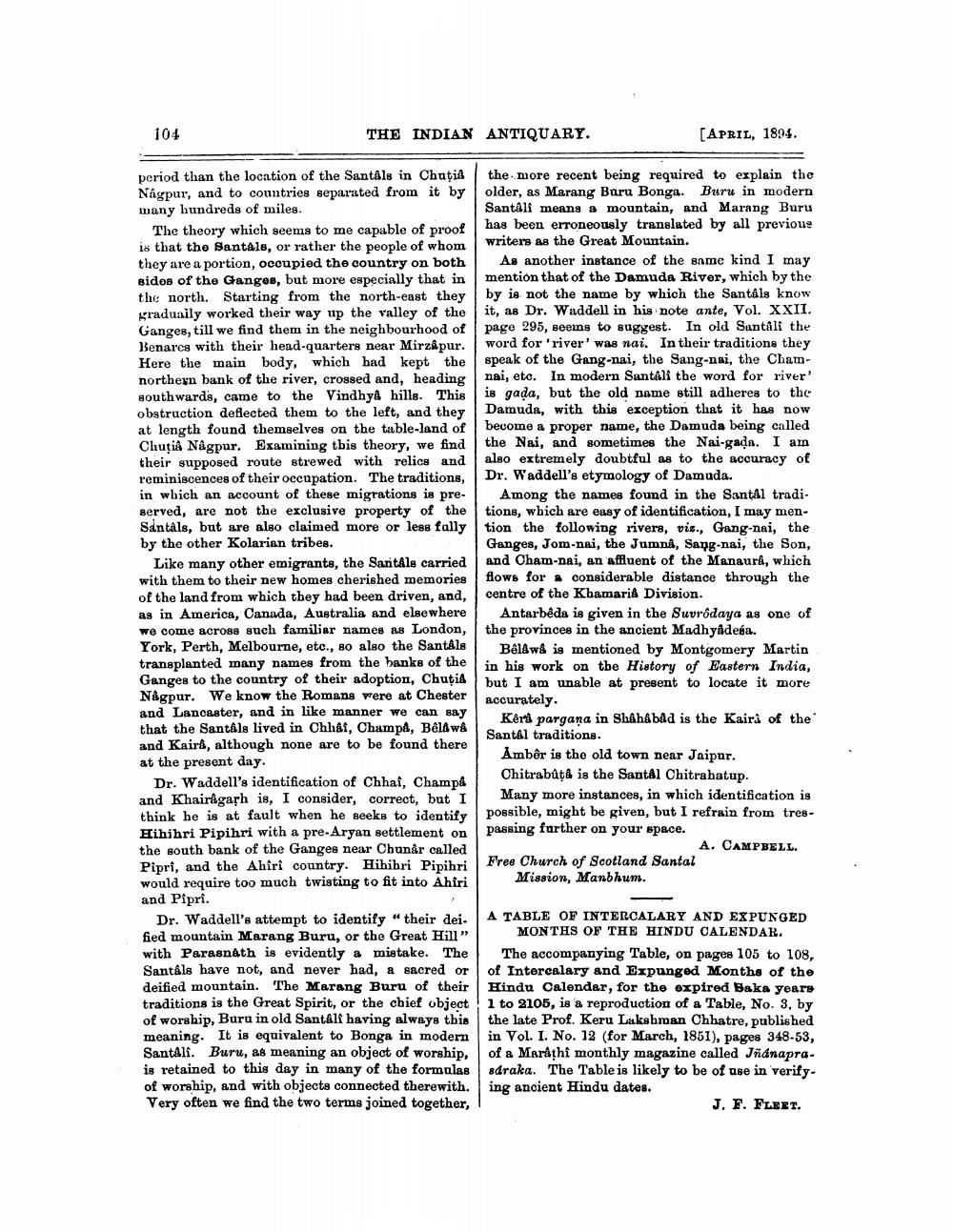________________
104
THE INDIAN ANTIQUARY.
[APRIL, 1894.
period than the location of the Santâls in Chatiš the more recent being required to explain the Nagpur, and to countries separated from it by older, as Marang Baru Bonga. Buru in modern many hundreds of miles.
Santali means a mountain, and Marang Buru The theory which seems to me capable of proof
has been erroneously translated by all previous is that the Santals, or rather the people of whom
writers as the Great Mountain. they are a portion, occupied the country on both As another instance of the same kind I may sides of the Ganges, but more especially that in mention that of the Damuda River, which by the the north. Starting from the north-east they by is not the name by which the Santâls know graduaily worked their way up the valley of the it, as Dr. Waddell in his note ante, Vol. XXII. Ganges, till we find them in the neighbourhood of page 295, seems to suggest. In old Santali the Benares with their head-quarters near Mirzâpur. word for 'river' was nai. In their traditions they Here the main body, which had kept the speak of the Gang-nai, the Sang-nai, the Cham
rthern bank of the river, crossed and, heading nai, etc. In modern Santali the word for river' southwards, came to the Vindhya hills. This is gada, but the old name still adheres to the obstruction deflected them to the left, and they Damuda, with this exception that it has now at length found themselves on the table-land of become a proper name, the Damuda being called Chuția Nagpur. Examining this theory, we find the Nai, and sometimes the Nai-gada. I ain their supposed route strewed with relics and also extremely doubtful as to the accuracy of reminiscences of their occupation. The traditions, Dr. Waddell's etymology of Damuda. in which an account of these migrations is pre- Among the names found in the Santal tradiserved, are not the exclusive property of the tions, which are easy of identification, I may menSantals, but are also claimed more or less fally tion the following rivers, vis., Gang-nai, the by the other Kolarian tribes.
Ganges, Jom-nai, the Jumna, Sang-nai, the Son, Like many other emigrants, the Santale carried and Cham-nai, an affluent of the Manaura, which with them to their new homes cherished memories flows for considerable distance through the of the land from which they had been driven, and, centre of the Khamarid Division. as in America, Canada, Australia and elsewhere Antarbêda is given in the Suvródaya as one of we come across such familiar names as London, the provinces in the ancient Madhyadeba. York, Perth, Melbourne, etc., so also the SantAls Beldwa is mentioned by Montgomery Martin transplanted many names from the banks of the l in his work on tbe History of Eastern India, Ganges to the country of their adoption, Chuţia but I am unable at present to locate it more Nagpur. We know the Romans were at Chester
accurately. and Lancaster, and in like manner we can say
Kéri pargana in Shåhåbåd is the Kairi of the that the Santâls lived in Chh&i, Champå, Bêlê wê
Santal traditions. and Kaira, although none are to be found there
Ambôr is the old town near Jaipur. at the present day.
ChitrabûţA is the Santal Chitrabatup. Dr. Waddell's identification of Chhai, Champa and Khairagash is, I consider, correct, but I
Many more instances, in which identification is think he is at fault when he seeks to identify possible, might be given, but I refrain from tresHihihri Pipihri with a pre-Aryan settlement on passing farther on your space. the south bank of the Ganges near Chunâr called
A. CAMPBELL. Pipri, and the Ahiri country. Hihibri Pipihri
Free Church of Scotland Santal would require too much twisting to fit into Ahiri
Mission, Manbhum. and Pipri. Dr. Waddell's attempt to identify their dei.
A TABLE OF INTERCALARY AND EXPUNGED fied mountain Marang Buru, or the Great Hill ”
MONTHS OF THE HINDU CALENDAR. with Parasnath is evidently a mistake. The The accompanying Table, on pages 105 to 108, Santâls have not, and never had, a sacred or of Intercalary and Expunged Months of the deified mountain. The Marang Buru of their Hindu Calendar, for the expired Baka years traditions is the Great Spirit, or the chief object 1 to 2105, is a reproduction of a Table, No. 3, by of worship, Buru in ola Santálf having always this the late Prof. Keru Lakshman Chhatre, published meaning. It is equivalent to Bonga in modern in Vol. I. No. 12 (for March, 1851), pages 348-53, Santall. Buru, as meaning an object of worship, of a Marathi monthly magazine called Jidnapra. is retained to this day in many of the formulas sdraka. The Table is likely to be of use in verifyof worship, and with objects connected therewith. ing ancient Hindu dates. Very often we find the two terms joined together,
J. F. FLEET.




